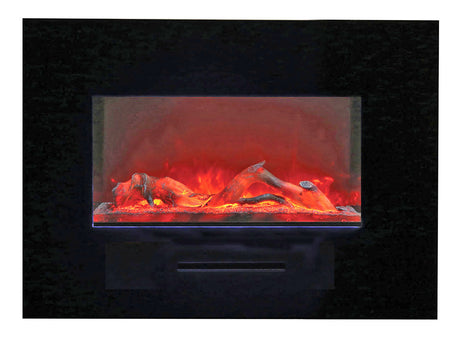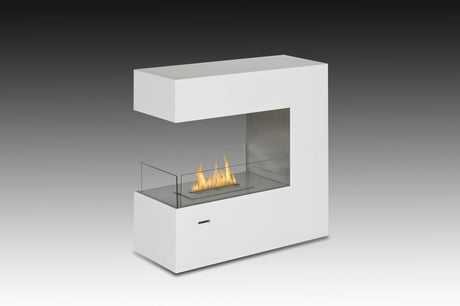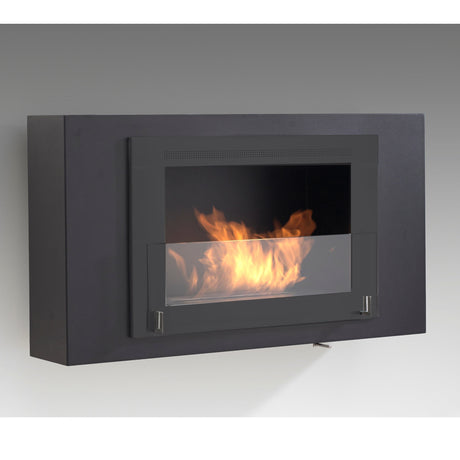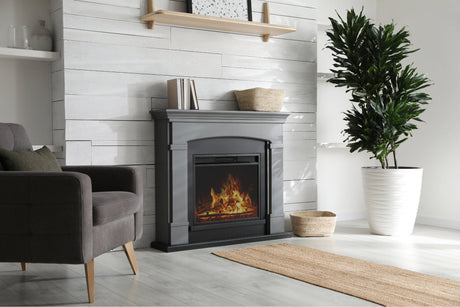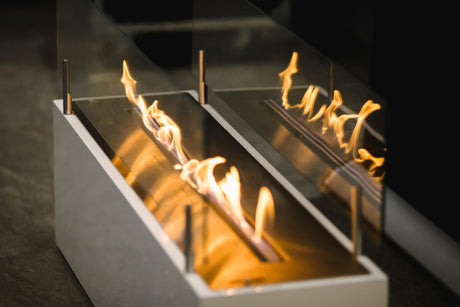Choosing the perfect fireplace for your living room can be challenging, especially when deciding between electric and gas options. Both offer unique benefits and potential drawbacks, depending on your home’s setup, your aesthetic preferences, and your heating needs.
Let’s break down the main differences between electric and gas fireplaces to help you determine which one best suits your lifestyle.
Electric vs. Gas Fireplaces Installation & Setup
Is It Easy to Install a Gas Fireplace?
Gas fireplaces generally require professional installation and a gas line, making them ideal for homes with pre-existing gas connections or for larger renovation projects.
There are two main types of gas fireplaces: vented and ventless. Vented gas fireplaces require a flue or chimney to release combustion byproducts, which can involve higher installation costs. Ventless models are more flexible since they don’t require exterior venting but need adequate ventilation to prevent moisture buildup.
Is It Easy to Install an Electric Fireplace?
Electric fireplaces are incredibly easy to install—many simply plug into a standard outlet, making them ideal for apartments, condos, and any room that lacks a built-in fireplace. They don’t require chimneys, venting, or gas lines, and many can be wall-mounted, built-in, or freestanding, giving you more flexibility with placement.
The Winner: Electric fireplaces are more convenient to install, especially if you want a hassle-free setup with minimal renovation.
Electric vs. Gas Fireplaces Heating Capabilities
Do Gas Fireplaces Give Off Heat?
Gas fireplaces are well-regarded for their powerful heat output, making them a strong option for larger rooms. A gas fireplace can typically heat areas of up to 1,000 square feet, providing a consistent warmth that’s great for colder climates. Many models have thermostats, which allow you to control the heat output efficiently.
Do Electric Fireplaces Give Off Heat?
Electric fireplaces provide supplemental heat, best suited for rooms up to 400 square feet. Most models feature adjustable settings, allowing you to choose between different heat levels or operate the unit without any heat at all, creating ambiance year-round. However, they aren’t as powerful as gas fireplaces when it comes to warming larger spaces.
The Winner: Gas fireplaces are the go-to choice if you need a strong heat source, but electric fireplaces work well for smaller rooms or as supplementary heating.
Electric vs. Gas Fireplaces Energy Efficiency
Are Gas Fireplaces Energy Efficient?
Gas fireplaces are generally more energy-efficient than traditional wood-burning fireplaces, especially if they have a high-efficiency rating. However, they can still lose some heat through venting (if it’s a vented model), which reduces efficiency.
Are Electric Fireplaces Energy Efficient?
Electric fireplaces are 100% energy-efficient, as all the electricity they consume is converted into heat. Since they don’t require venting, there’s no energy loss, making them highly efficient in terms of energy usage. They also allow for zone heating, letting you heat only the rooms you’re using, which can save on energy costs.
The Winner: Electric fireplaces have a slight edge in energy efficiency, especially when used for zone heating.
Electric vs. Gas Fireplaces Realism and Ambiance
Do Gas Fireplaces Offer Realistic Flames?
Gas fireplaces offer realistic flames that closely mimic a traditional wood fire. Many modern models even come with ceramic logs and embers, making them visually comparable to a real fire. The flames are natural-looking and, combined with the heat, create an authentic and cozy atmosphere.
Do Electric Fireplaces Offer Realistic Flames?
Electric fireplaces have come a long way in terms of flame realism. Some high-end models use LED lights and reflectors to create lifelike flames and can even simulate different colors and flame effects. However, while they add ambiance, they don’t perfectly replicate the flicker and warmth of real flames.
The Winner: Gas fireplaces are typically more realistic, though electric models are close contenders with modern flame technology.
Electric vs. Gas Fireplaces Maintenance Requirements
Gas Fireplaces Maintenance
Gas fireplaces require periodic maintenance, such as inspecting the gas line, checking for any obstructions in the vents, and cleaning the burner and pilot light area. While gas fireplaces don’t produce ash, they can accumulate residue on the glass that requires cleaning.
Electric Fireplaces Maintenance
Electric fireplaces are nearly maintenance-free. They don’t have any moving parts (aside from fans) or need for venting, which reduces the maintenance burden. Occasionally dusting the unit and replacing bulbs (if needed) are usually all that’s required.
The Winner: Electric fireplaces are much easier to maintain, making them ideal for busy homeowners.
Electric vs. Gas Fireplaces Safety Considerations
Gas Fireplaces
Gas fireplaces are safe when used properly, but they require a functioning carbon monoxide detector to monitor for leaks. Gas fireplaces also produce open flames, so proximity to flammable materials should be monitored.
Electric Fireplaces
Electric fireplaces don’t produce any real flames, making them safer for households with kids or pets. They also stay relatively cool to the touch, reducing burn risks. Since they don’t release combustion byproducts, they’re considered a safer option for indoor use.
The Winner: Electric fireplaces have an advantage in terms of safety, especially in homes with children or pets.


